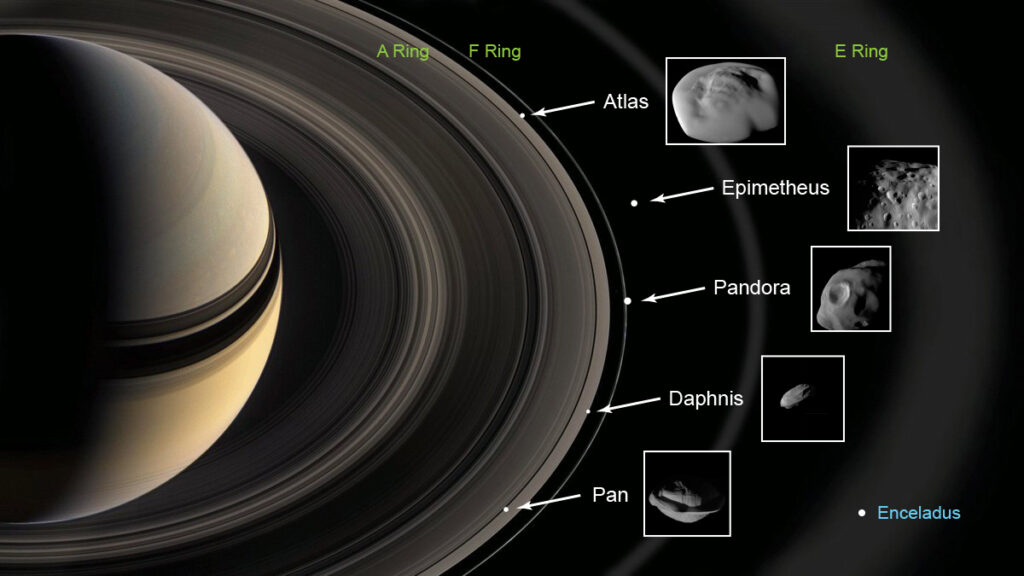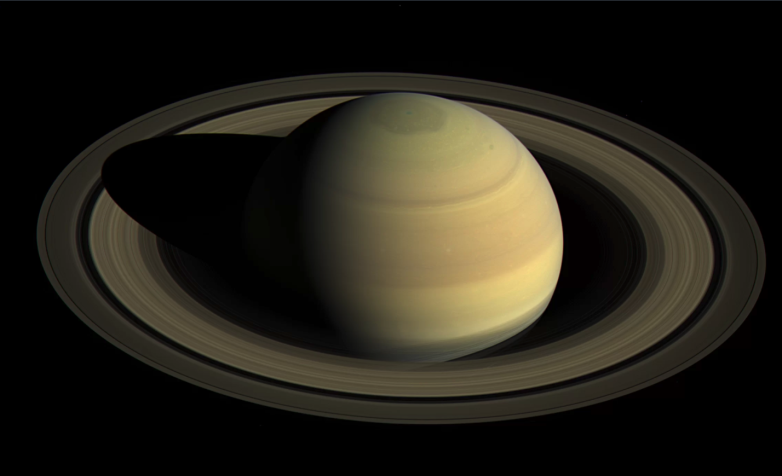Saturn’s rings are thought to be made of comets, space rocks, or broken moons that split up before they arrived at the planet, destroyed by Saturn’s intense gravity. Apparently, it is disclosed that they are made of billions of tiny lumps of ice and rock covered with different materials like residue. Saturn’s frigid rings are not simply aesthetical wonders. One of them likewise records a lovely planetary soundtrack.
Saturn’s unusual ring
Since the hour of the Voyager flybys of Saturn in 1980-1981, Saturn’s unusual F ring has been known to go with on one or the other side by faint strands of material. Cassini’s perceptions show that these strands, at first deciphered as concentric ring fragments, are truth be told associated and structure a solitary one-arm following twisting something like multiple times around Saturn.
The winding turns around Saturn with the orbital movement of its constituent particles. This design is possible the aftereffect of differential orbital activity extending an underlying haze of particles dispersed from the thick center of the F ring. Various situations of arrangement, suggesting curl satellite communications, are investigated. A late found moon applicant, S/2004 S6, is on a circle that crosses the F-ring center at the convergence of the winding with the ring, which recommends a dynamical association between S/2004 S6 and the twisting (Cassini,2005).

Saturn’s broad C ring
The Saturn planet inside, covered underneath a cover of, for the most part, hydrogen gas, writhes. This causes shifts in the neighborhood gravity field, which pulls at particles in Saturn’s broad C ring and makes them dance. These peculiar skips can appear as twisting waves, and unmistakable arrangements of waves uncover the attributes of specific highlights of Saturn’s internal parts.
The viewpoint math of Saturn’s rings shows shut structure articulations to assessing a space apparatus’ general situation just as its scientific covariance. Mathematical reenactments detail the presentation and awareness of the position gauges. An Extended Kalman Filter melds the broad position gauges with rocket elements for precise relative position and speed.
An Enceladus test assortment mission fills in as a contextual analysis where the proposed strategy appears to be suitable. With sifting, reproduction of an Enceladus test assortment mission accomplishes the most extreme three-sigma limits of 43 km and 0.024 km/s for relative position and speed gauges, separately, during its Enceladus experience. An Independent route might lessen the expense of such a mission to where a few little rockets can accomplish the science goals (Kalani R.,2022).
Saturn losing its rings
New NASA research affirms that Saturn is losing its unique rings at the most extreme rate assessed from Voyager 1 and 2 perceptions made many years prior. The rings are maneuvered into Saturn by gravity as a dusty downpour of ice particles affected by Saturn’s attractive field.
“We gauge that this ‘ring precipitation’ depletes a measure of water items that could fill an Olympic-sized pool from Saturn’s rings in thirty minutes,”
~ ( James O’Donoghue of NASA’s Goddard Space Flight Center in Greenbelt, Maryland.)
“By itself, the whole ring framework will be gone in 300 million years. However, add to this, the Cassini-space apparatus estimated ring-material distinguished falling into Saturn’s equator, and the rings have under 100 million years to live. This is somewhat short, contrasted with Saturn’s period of more than 4 billion years.” O’Donoghue is the lead creator of a review on Saturn’s ring precipitation showing up in Icarus on December 17, 2018 (Nasa,2018).
The internal construction of Saturn and its rings
The best requirements on the interior constructions of goliath planets have generally come from estimations of their gravity fields. For the most part, this gravity information is intrinsical delicate to a planet’s external areas, giving just free imperatives on the profound insides of Jupiter and Saturn. This significant limit obstructs endeavors to quantify the mass and conservativeness of these planets’ centers, urgent properties for understanding their development pathways and advancement.
Nonetheless, investigations of Saturn’s rings have uncovered waves driven by throb modes inside Saturn, offering independent seismic tests of Saturn’s inside. The perceptions reveal gravity mode (g mode) throbs, showing that creation angles steadily separate Saturn’s interior. The g mode frequencies straightforwardly test the lightness recurrence inside the planet.
Here, we contrast primary models and gravity and seismic estimations to show that the information must be clarified by a diffuse, steadily separated center envelope progress area in Saturn reaching out to roughly 60% of the planet’s sweep and containing around 17 Earth masses of ice and rock. The slow dispersion of weighty components compels blending processes at work in Saturn, and it might mirror the planet’s early-stage construction and gradual addition history (Christopher Mankovich, 2021).
References
- https://technologytimes.pk/2021/07/31/saturn-visible-from-he-earth-next-week-heres-how-to-spot-the-planet-and-its-rings-at-night/
- https://arc.aiaa.org/doi/pdfplus/10.2514/6.2022-1225
- https://arxiv.org/abs/2104.13385
- https://www.nasa.gov/press-release/goddard/2018/ring-rain

Samra Hayat Khan is a Biotechnologist, currently works in a pharmaceutical company as a research and development officer. Samra is a passionate advocate for marine sciences, their unparalleled benefits for humankind, and their significance for saving mother earth.

